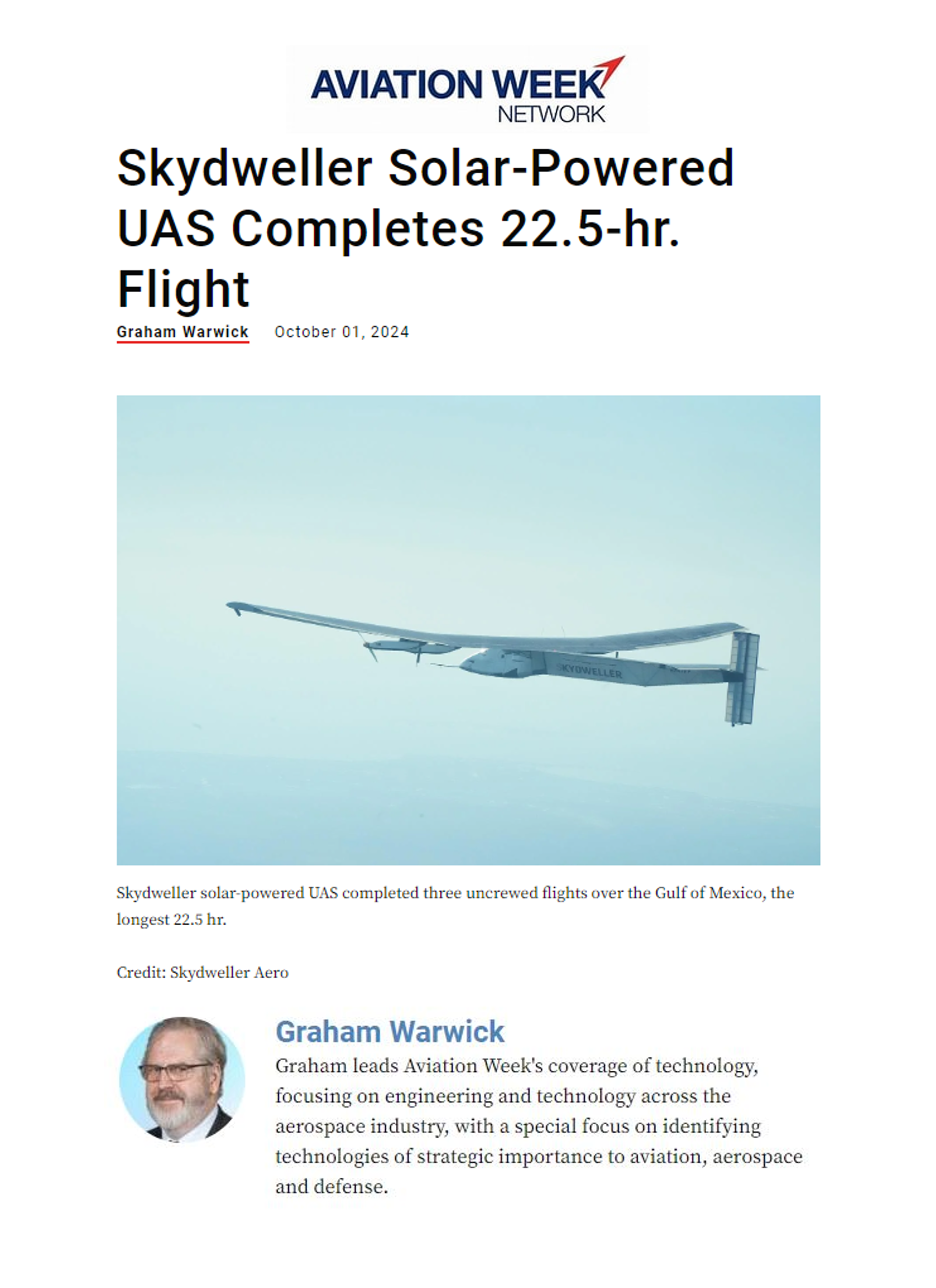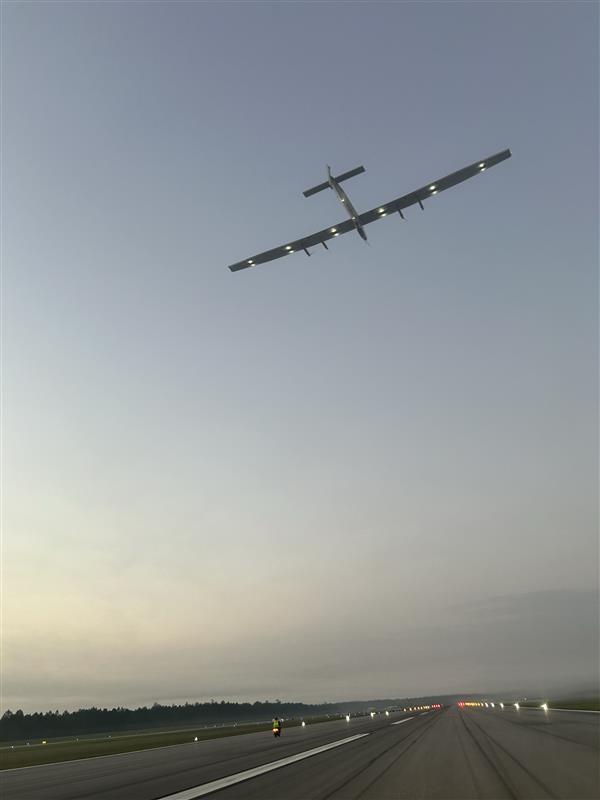
Oklahoma Firm Working Toward ‘Perpetual Flight’ – AVweb
Skydweller Aero advances autonomous solar aircraft testing for operational deployment in 2025
Skydweller Aero advances autonomous maritime patrol aircraft testing with military payloads
Skydweller Aero continues AMPA flight tests with operational military payloads | CompositesWorld
Skydweller Aero continues flight tests with operational military payloads – Air Cargo Week
Skydweller Aero continues Autonomous Maritime Patrol Aircraft (AMPA) Flight Tests – Naval News
Skydweller Aero Continues AMPA Flight Tests with Operatioanl Military Payloads
Skydweller continues tests – IOT Insider
Skydweller Aero advances flight tests for its Autonomous Maritime Patrol Aircraft – Defense Here
Solar aircraft soars with groundbreaking 22-hour autonomous flight mission. | USA Solar Cell
NASA Stennis to support unmanned aircraft testing – Machinery Market News
MS Stennis Space Center tests uncrewed aircraft
NASA Stennis expands range operations with new Skydweller Aero agreement
NASA Stennis Takes Key Step in Expanding its Range Operations Work – WXXV News 25
NASA Stennis Expands Range Operations Efforts | Mirage News
Skydweller Aero allowed use of NASA Stennis Space Center restricted airspace – Magnolia Tribune
NASA Stennis takes key step in expanding its range operations work | News | seacoastecho.com
U.S. Navy Eternal Drone Signals The Dawn Of Practical Solar Flight (forbes.com)
Solar-powered plane off Gulf Coast could spend months in air | Business News | nola.com
Skydweller Completes Autonomous Solar-Powered Flight Tests | RealClearDefense
Aviation Week features Skydweller Aero – “Solar-Powered UAS Completes 22.5 hour Flight” – Skydweller
SkyDweller Aero completes tests of ultra-long-endurance solar aircraft | News | Flight Global
Skydweller Aero Completes Successful Uncrewed Solar Flight Tests (botsanddrones.uk)
Skydweller Aero Successfully Completes “First Uncrewed Flight Test Campaign” – eVTOL Insights
Skydweller Aero: The 90-Day Solar Flight Revolution (aircomment.info)
World Military News: Skydweller Completes Autonomous Solar Powered Flight Tests
First flight: Solar-powered Skydweller — General Aviation News
Game-Changer: Solar-Powered Skydweller Drone Flies for 22.5 Hours in Breakthrough Test (msn.com)
Skydweller successfully concludes series of autonomous flights – IOT Insider
Skydweller Aero completes initial uncrewed flight test campaign – SatNews
Skydweller Aero successfully completes initial uncrewed flight test campaign – Air Cargo Week
Skydweller Aero completes autonomous flight test campaign | CompositesWorld
Skydweller Aero Completes Uncrewed Flight Testing | Aero-News Network
Skydweller completes initial flight test campaign | Revolution.aero
Skydweller Aero Successfully Completes Uncrewed Flight Test Campaign | UAS Magazine
Solar-Powered ‘Skydweller’ Drone Flies 22.5 Hours in Test (thedefensepost.com)
Skydweller’s solar UAS aces test flight campaign, hitting milestones. | USA Solar Cell
Skydweller Autonomous Solar Flight Test Completed (defencetrend.com)
News :: Airplanes :: Skydweller completes initial flight test campaign (avfoil.com)
Skydweller Aero Triumphs with Record-Setting Uncrewed Aerial Tests – UASweekly.com
Skydweller’s solar-powered UAS completes test flight campaign (aerospaceglobalnews.com)
US tests Skydweller drone with solar panels (gagadget.com)
Skydweller drone completes first uncrewed flight test campaign | Aerospace Testing International
Skydweller completes autonomous solar-powered flight tests (defence-blog.com)
Skydweller Aero Successfully Completes Uncrewed Flight Test Campaign | UAS Magazine
Skydweller Aero Successfully Completes Initial Uncrewed Flig (asdnews.com)
Solar-power drone completes flight test for U.S. military – Military Embedded Systems
U.S. has tested an eternal drone: What you need to know | News.az
A solar-powered plane flies continuously for more than 20 hours: this is Skydweller
FOX’s CyberGuy Features Skydweller Aero
Solar-powered aircraft achieves groundbreaking 22-hour autonomous flight
How perpetual flights could soon be reality
Imagine an aircraft that can stay airborne for weeks, even months, without refueling. This isn’t futuristic fantasy.
Skydweller Aero is working toward turning this vision into reality with its innovative solar-powered plane.
As the world’s largest unmanned solar-powered aircraft, Skydweller is pushing the boundaries of what’s possible in aviation.
The Skydweller advantage
What sets Skydweller apart from its predecessors? Its foundation is built on the Solar Impulse, the first solar-powered aircraft to circumnavigate the globe. This heritage provides Skydweller with a robust design capable of carrying substantial payloads. With a wingspan of 236 feet (larger than a 747) and weighing just 5,620 pounds (about the same weight as a Ford F150), the Skydweller can carry up to 800 pounds of payload.
A milestone achievement
Skydweller Aero recently achieved a significant milestone by completing a series of uncrewed autonomous flight tests. The longest of these flights lasted an impressive 22½ hours, launched from the company’s facility at Stennis International Airport in Kiln, Mississippi. This achievement demonstrates the feasibility of remaining airborne for extended periods using solar energy and batteries.
Kurt’s key takeaways
As the world’s largest unmanned solar aircraft, Skydweller Aero is revolutionizing aviation and opening up exciting new possibilities. From enhancing maritime patrols to serving as airborne communication platforms, the potential applications are vast.
Watch / read FOX’s CyberGuy Feature Skydweller Aero:
Link to video – https://www.foxnews.com/video/6364663907112
Link to article – Solar-powered aircraft achieves groundbreaking 22-hour autonomous flight | Fox News Video

Share the joy and triumph of our recently completed flight test campaign by watching this Skydweller Aero video, available here
A huge solar-powered plane is being tested off the Mississippi coast. It could spend months in the air.
The company behind the airplane says first batch of tests showed their technology will work.
BY BOB WARREN | Staff writer
An aviation company pushing the boundaries of solar-powered flight has successfully finished the first in a series of tests for its uncrewed airplane, taking off from Mississippi’s Stennis International Airport for six flights high over the Gulf of Mexico.
The company, Skydweller Aero Inc., says its aircraft — essentially a giant drone with a wingspan greater than a 747 — had one flight lasting 22.5 hours and another lasting 16 hours during the initial testing campaign.
The success of the initial tests marks “a new era in autonomous aviation,” Skydweller Aero CEO Robert Miller said.
So much so that the company is in the process of building two additional solar-powered planes. They will be assembled at Stennis, Miller said.
The company says it is developing technology to enable its airplanes to eventually spend months cruising at 40,000 feet, guided by a team of techs on the ground and using only the sun for fuel. The top of the plane is equipped with 17,000 solar cells that spend the day collecting sunlight, then store that energy in batteries that power the plane.
Skydweller Aero unveiled its airplane, also called Skydweller, last March during a media event that drew Mississippi Gov. Tate Reeves and both the Magnolia State’s U.S. senators. The company has since been testing it over the Gulf, taking off and landing at Stennis’ airstrip in Kiln, a 15-minute drive from the Louisiana state line.
During the initial round of testing “things generally worked as we planned and simulated,” Miller said.
The flights were overseen from a control room at the company’s Stennis site and monitored from the company’s offices in Oklahoma City and Madrid.
What’s next?
Next up is to “integrate payloads,” that is the surveillance equipment the aircraft will use on its missions over the Gulf or Caribbean Sea, Aero CEO Robert Miller said this week.
Miller said the early test flights have been a success and mark a huge step forward for the company.
“We are excited to continue pushing the boundaries of what uncrewed solar-powered aircraft can achieve,” Miller said.
The testing is being performed in a partnership of sorts with the U.S. military. The Navy had awarded the company a $5 million development contract in 2021, and Miller said more military contracts are in the works “for significantly more than that.”
At the time its airplane was publicly unveiled last spring, the company and state officials said Skydweller Aero’s work would continue a rich tradition of aviation innovation along the coast, noting the proximity of the company’s operations to NASA’s John C. Stennis Space Center nearby.
Reeves and the other elected officials also touted the company as a potential jobs producer.
And that might already be coming to fruition.
Miller said one new airplane is expected to be complete by the end of next year and the other sometime in 2026. And the company says it expects the full-time workforce to grow from 15 now to 65-75 in the next couple of years.
The assembly is painstaking and precise.
“You don’t just put a 236-foot wingspan aircraft together in your garage,” he said with a chuckle.
The original article, including photos exclusive to the Times-Picayune, can be accessed here: Solar-powered plane off Gulf Coast could spend months in air | Business News | nola.com]
Social Media Influencer “Papa Mississippi” is a proud Mississippian.
He is so happy that Skydweller Aero flies from Stennis International Airport in Kiln that he made this video.
Enjoy!

The Oklahoma-headquartered firm on 30 September said the Skydweller UAS successfully conducted a series of autonomous long-duration flights in recent weeks, including one sortie lasting 22h 30min and another spanning 16h.
SkyDweller Aero completes tests of ultra-long-endurance solar aircraft | News | Flight Global

The complete article can be accessed here (subscription required): Skydweller Solar-Powered UAS Completes 22.5-hr. Flight | Aviation Week Network
Excerpted from Aviation Week:
…the Sept. 22 mission demonstrated the feasibility of staying airborne for weeks to months on solar power and batteries. “The data gathered validates our model for multiday flights,” co-founder and CEO Robert Miller says.
The flights also showed the aircraft’s ability to fly in operationally relevant weather. “We’re not flying in Yuma in July. We’re flying over the Gulf Coast in hurricane season,” he says, referring to previous record-setting solar-powered UAS flights conducted over Yuma Proving Ground in Arizona.
Autonomous flights with no pilot on board began with a 3-hr. 10-min. mission on. Sept 14. A 16-hr. 11-min. flight followed on Sept 19-20 and led up to the 22-hr. 22-min autonomous flight on Sept 21-22. The flight was cut short because of the risk of high winds from the approaching Hurricane Helene.
“We got plenty of data from the 16-hr. and 22.5-hr. flights that shows we can do perpetual flight,” Miller says. Another reason for truncating the final mission was the aircraft is flying on new, high-performance batteries, leading to concerns about performance at low voltage after powering the aircraft through the night. But the flight showed “we have more margin than we thought we had,” he says.
The longer flights also demonstrated the aircraft ’s redundancy and turnaround between missions. A circuit breaker failed early on the 16-hr. flight, but the system redundancy handled the failure correctly and the aircraft flew on for another 13 hr., Miller says. The breaker was replaced aft er landing and a day later the aircraft was launched again. “We put a new one in and it flew for 22.5 hours,” he says.
The flights also showed the aircraft ’s ability to operate in the vicinity of weather, as the 16-hr. flight was conducted with developing thunderstorms in the area. “This shows we can fly in an operationally relevant environment,” Miller says. This supports the Skydweller UAS’ use for long-duration missions from the U.S. over the Caribbean and West Africa where the Pentagon does not have forward bases.
Because of its size…the Skydweller UAS can carry heavier payloads than other solar-powered and most medium-altitude uncrewed aircraft. The aircraft is flying with two line-of-sight data links and three satellite communications systems—Iridium, Inmarsat and Skylight—with a fourth to be added. “That’s a lot of capacity,” he says.
Seeing Skydweller in flight for the first time, some southern Mississippi folks enjoying themselves on the bayou made this video.
Even without a video, seeing Skydweller in flight for the first time is likely something they will never forget.

Skydweller is the world’s largest uncrewed, all-carbon fiber aircraft with a wingspan greater than a 747 and weigh about the same as a Ford F-150, capable of performing extreme endurance flights with heavy, powerful payloads. Skydwellers will be used for ultra-long duration missions such as providing exclusive economic zone enforcement, monitoring naval activity, and detecting drug smugglers and pirates at sea, and will accomplish these missions with zero carbon footprint.

